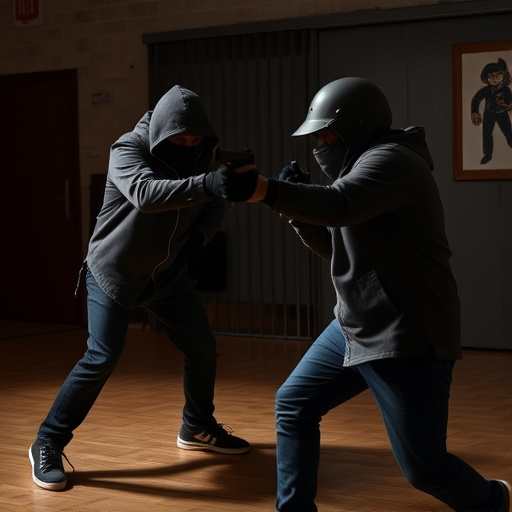Tactical pepper spray deployment methods vary based on distance, crowd behavior, and environment. Officers use precise spraying for disorientation or fogging techniques for broader control. Strategic deployment minimizes damage, injuries, and chaos while maintaining order. Safety is paramount, with proper training, equipment guidelines, personal protective gear, and proficiency checks essential. Exploring diverse methods like Tasers, rubber bullets, and riot shields enhances crowd management safety.
“In situations requiring crowd control, law enforcement often relies on tactical pepper spray as a powerful tool. This comprehensive guide explores the strategic deployment of this potent agent, offering insights into its effectiveness and safe handling. From understanding the mechanics of tactical pepper spray to examining various deployment methods, we delve into best practices for optimal use. Additionally, we discuss safety considerations and alternative strategies, ensuring a balanced approach to crowd control.”
- Understanding Tactical Pepper Spray: A Comprehensive Guide
- Crowd Control Strategies: When and How to Deploy
- Safety Considerations: Training and Equipment Guidelines
- Effectiveness and Alternatives: Exploring Other Options
Understanding Tactical Pepper Spray: A Comprehensive Guide
Tactical pepper spray is a powerful tool in law enforcement’s arsenal, designed for crowd control and riot suppression. It works by targeting the eyes, nose, and respiratory system, causing temporary incapacitation through intense irritation. Understanding its deployment methods is crucial for both officers and the public to ensure safety and effectiveness during volatile situations.
Deployment techniques vary based on factors like distance, crowd behavior, and environmental conditions. Officers may use spray cans or advanced devices that allow for more precise applications. Direct spraying at close range is effective for disorienting individuals, while fogging techniques create a larger barrier, enabling faster movement through crowds. In dynamic scenarios, tactical teams employ strategic deployment to control chaos, ensuring minimal damage and injuries while maintaining order.
Crowd Control Strategies: When and How to Deploy
Crowd control is a delicate balance, requiring tactical decisions based on real-time assessments. When faced with large gatherings or potential unrest, law enforcement agencies often employ a range of strategies to maintain order and ensure public safety. One such tool that has gained prominence in recent years is tactical pepper spray.
The deployment of tactical pepper spray should be carefully considered and executed. Officers must first assess the crowd’s behavior and size, determining if it poses an immediate threat. If the crowd appears peaceful but still requires dispersal, a strategic approach is key. This might involve using sound management techniques, such as loud speakers to communicate instructions, or even the controlled deployment of pepper spray canisters to create a barrier without causing harm. In more volatile situations, direct application of pepper spray may be necessary, targeting individuals engaging in aggressive behavior or throwing objects to incapacitate them momentarily and facilitate control. The method should always prioritize safety, minimizing impact on bystanders, and respect for human rights.
Safety Considerations: Training and Equipment Guidelines
When employing tactical pepper spray for crowd control, safety considerations are paramount. Proper training is crucial for officers to ensure they understand the potential risks and effects of the chemical agent. This includes learning different deployment methods, such as aiming techniques, distance control, and managing wind direction, all of which play a significant role in minimizing bystanders’ exposure.
Equipment guidelines are also essential. Officers should be equipped with high-quality, non-lethal pepper spray devices that meet specific performance standards. Regular maintenance and proficiency checks on equipment ensure reliability during operations. Additionally, providing personal protective gear, such as eye protection and durable clothing, further safeguard both the officers and the public from potential harm or adverse reactions.
Effectiveness and Alternatives: Exploring Other Options
While tactical pepper spray is widely used for crowd control due to its effectiveness in temporarily incapacitating individuals, it’s crucial to explore alternative deployment methods and consider their pros and cons. Traditional spraying from a distance has its limitations—it can be imprecise, leading to accidental exposure of bystanders or even friendly fire. Additionally, weather conditions can significantly impact the spray’s range and potency.
Investigating other tactical crowd control options is essential for law enforcement agencies looking to enhance safety and minimize harm. These alternatives include non-lethal weapons like Tasers, rubber bullets, and riot shields. Each method has unique advantages; for instance, Tasers offer a more targeted stun while riot shields provide physical barriers. Exploring these diverse tactical pepper spray deployment methods allows for a more nuanced approach to crowd management, ensuring the safety of both officers and citizens.
Tactical pepper spray, while an effective crowd control tool, should be deployed strategically and with caution. Understanding the various deployment methods, such as aerial or direct application, is key to ensuring safety and maximizing effectiveness during demonstrations or public disturbances. Proper training and adherence to equipment guidelines are essential to prevent harm and maintain order. As we’ve explored, evaluating alternatives to pepper spray can also provide valuable options for crowd management, promoting a balanced and safe approach in the field of law enforcement.
